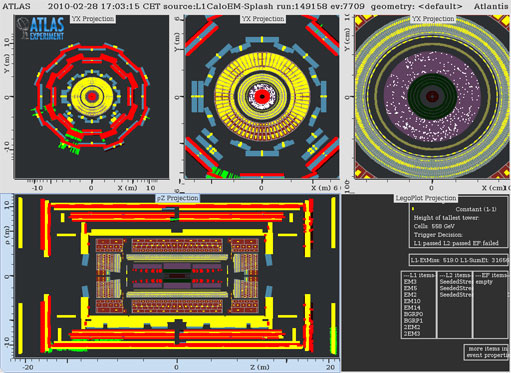
ATLAS e-News
23 February 2011
2010 beams are here
8 March 2010

A February 28th splash event.
As most of you will have already heard by now, the 2010 ATLAS physics run got off to a smooth start in the early hours of Sunday February 28th. Beams circulated in both directions and, later in the day, beam splashes lit up the whole detector, which can be roughly translated as a resounding ‘Hello, I’m ready for action’.
Martin Aleksa, who officially took up his position as Deputy Run Coordinator on Monday March 1st, was in the Control Room getting a first taste of the next two years of his life. “We were waiting, running in beam splash mode since Thursday,” he recalls, but some minor setbacks with the machine had them holding on a little longer.
“On Saturday, they told us all day that the beams might come. For me it’s rather human how this shifts, because they’re also commissioning their machine, but it’s also a bit tough to plan,” he says. “I didn’t dare to go too far from CERN, and Christophe [Clement, outgoing Run Coordinator] was here all the time very close to CERN too.”
Eventually, beams were confirmed for 6pm, but this slipped to 8pm, then 11pm when a sector tripped, and finally to 12:30am. At this point Christophe sent Martin home to bed so he’d be fresh the following day, but having been at the centre of the excitement all day, sleep was not forthcoming. “I’d spent the whole day checking the LHC webpage every 10 minutes,” he smiles. “They don’t speak a lot actually, but every now and then there is at least a two-line update on what’s going on.”
Around 1:30am, half an hour after confirming that Beam 1 would finally be on it’s way soon, the screen flashed up ‘Setting up Beam 2’, which sent the ATLAS Control Room into a flurry of activity.
“For us it makes a difference, because we have to change our Trigger settings. We were triggering on the far side of the detector, so we had to call up our Trigger expert,” Martin explains.
At 1:45am, Beam 2, the anticlockwise beam (or “the direction coming from Charly’s pub”, as Martin helpfully points out) was threaded through the LHC, reaching Point 1 at 2:38am ATLAS saw its first splash of 2010. As is usual for beam splash events, the sensitive silicon detectors were either switched off or were running at low voltage to protect them, but with a beam intensity more than twice that of the 2009 splashes (6 billion protons per bunch), the Beam Conditions Monitors (BCMs) still triggered a beam abort, forcing the LHC to wait for a new injection permit from ATLAS.
At 4:05am, Beam 1 was sent through ATLAS, again triggering a beam abort, and two distinct splash events were measured, exactly one turn apart. As yet, the reason for this is still not understood.
Instead of continuing with splashes at this point, the machine team practiced circulating the beam more than 100 times. With the beam intensity halved and the BCM tolerance thresholds raised the following day, the LHC delivered 20 splashes with Beam 1 and 10 with Beam 2, at around 17:00 and 21:30 respectively.
The summary from Martin is that ATLAS is really ready for collisions. “What I liked a lot was that it looked almost like a routine,” he smiles. “In 2008 and 2009 at the very beginning of the beam, the Control Room was packed with people; you couldn’t move.
“Now it was really nice. I was there, the shifters, the shift leader. So it was really very calm. There was no tension like there was before. Which is good because I think one can work better in such conditions.”
The LHC is pressing on with beam commissioning for the next week or so, after which point we can look forward to a short run of 900 GeV collisions before the beam energy starts being ramped. “They’re learning how to handle their machine,” Martin reminds, “so the planning is tentative and we have to follow on a 24 hour basis really.”
 Ceri PerkinsATLAS e-News
|